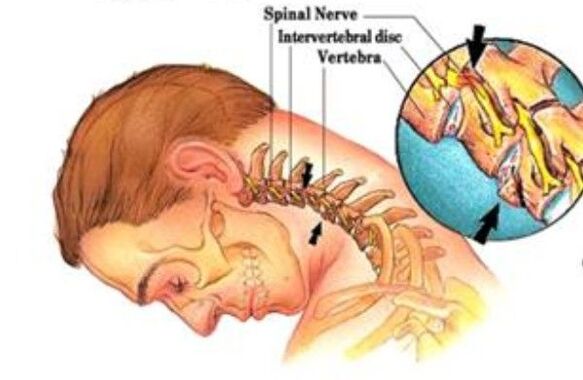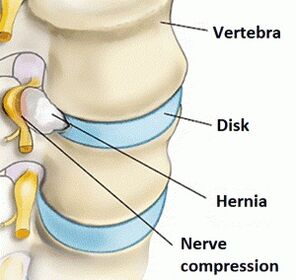
Cervical pain is alarming sign.Maybe it's just an overvoltage and you just have to relax and relax.But what if the pain is associated with osteochondrosis of the cervix?It is important to carefully consider the symptoms and treatment as complications can affect the most important organs - the brain.
What is cervical osteochondrosis
Cervical spine osteochondrosis is a degenerative disease of the body's bone cherry system.This leads to the destruction of the cervix intervertebral discs, to the increase of the vertebrae bone tissue and the growth of growth on their surface.
The cervical spine consists of seven vertebrae, the first of which is formulated with the skull.The anatomical and functional unit of the spine is the spinal engine segment.It is a common complex that causes the spinal column to move.The complex consists of two vertebrae, intervertebral discs, joint surfaces of the vertebrae (aspect), nerves, leagues and muscles.
Osteocondrosis begins with damage to the intervertebral disc and affects all surrounding tissues.Over time, the process leads to a violation of biomechanics of the whole spine.Osteochondrosis may develop injuries to intervertebral discs, nerve roots and blood vessels.
There are four stages of the pathological processes of the intervertebral disk: diet, weakening of the ligaments, damage to the disc and compression of nerves.

- Stage 1- They violate the conditions for the power and metabolism of the intervertebral disk.Due to the properties of the structure, discs are consumed only during movement.If not, the dyspropic tissue changes start: the disc is starving and dehydrated.The loss of water leads to the fact that the intervertebral disk cannot perform depreciation functions.The load of the fibrous ring increases, with cracks and tears.At the moment, less pain may occur.
- Section 2- In the second phase, the spinal segment ligament device occurs.The relationship becomes pathologically moving.The abnormal process of the disk is worsening, the hernia (prolaps) begins - leaking the pulpuose seed through the fibrous ring cracks.The pain becomes periodic.
- Section 3- In addition, the intervertebral disk is completely damaged.The pulpona core of the disc goes beyond the fibrous ring.The resulting hernia can violate the nerve roots.The inflammatory process develops.This is published by the worsening of pain, the so -called radicular syndrome.
- Stage 4- In the fourth stage, the defeat affects nearby tissues.It is possible to print the radical artery, which leads to a lack of blood supply to the spinal cord.As a result, the spine can be completely immobilized.
The first signs and the main symptoms
At the onset of osteochondrosis of the cervical region, discomfort, restriction of movement, and neck pain.This often does not affect the importance.
Over time, the pain increases, pain, sky, head, neck, shoulder blades, shoulders - it may develop the spine artery syndrome.The artery is tightened or cramped, the blood flow is disturbed.
In the cervical osteochondrosis 1-2 stages often occur in the blood vessel-related ophthalmic problems.In the face of darkness, blink, "flies", the appearance of colored spots in the eyes - all of which are symptoms of osteochondrosis.
The most common symptoms of cervical osteochondrosis are:
- Migraine, dizziness, nausea and cough.
- Hearing, ear pain, face.
- Motor disorders in the hands, feet.The sensitivity of the head can be a gap on the head.
- Pain in his hand.If a nervous spine is pinched, the whole area in which it sends impulses is harmed or "dropped".
In addition to the above symptoms, three main pain syndrome can be distinguished that accompany the cervix's spine.Syndrome is a whole complex of symptoms.Determination of Leading Pain Syndrome is important as the total treatment system is based on the pain of pain.And it is impossible to eliminate it without knowing the origin.
- Miofascial syndrome- Pain in skeletal muscles and adjacent fascia.The infringement is related to the overload, in which cramps, hypertension, painful nodes occur inside the muscles (starting points).
- Coordinated syndrome- Pain caused by extended pressing the roots of the spine.The process of hernial formation of osteocondrosis of the spine leads to the inflammatory reaction of the nerve fibers and subsequent inflammatory reaction.The pain spreads along the nerve.
- Aspect syndrome- Pain in vertebrates.The vertebrae from the second cervix has joint processes that are connected by curved (aspect) joints.In the case of osteochondrosis, the intervertebral discs are destroyed and their height is reduced, and this leads to a constant tension of the joint capsules of the curved joints.This causes pain.In fact, the pain increases by the end of the sun, especially in long -term emergency.
Causes of osteochondrosis in the cervical spine One of the most important causes of osteochondrosis is the development of the spine to high vertical load.People's ancestors walked on four legs like other mammals.They did not suffer in osteochondrosis, because in the horizontal position of the body, half of the pressure disconated to intra is as vertical.According to evolutionary regulations, the transition to straightening was not long and the spine simply did not have time to adapt to the high vertical load.So, together with straightening, man also acquired diseases of the muscle system system.
The more vulnerable neck of a person promotes its structure.The cervical class of a person consists of seven small mobile vertebrae, formulated by the type of children's pyramid.This design can hardly be called stable outside the rest.In addition, the muscle frame in this zone is weak and the loads can be high - all of this makes the neck vulnerable.Any injury has consequences.Even if the damage was in another spine, the load can cause osteochondrosis.
Another factor is aging.The formation of the skeleton and cartilage ends until 21, and the irreversible process of aging (degeneration) begins.The cartilage food is only done due to diffusion, and if the intervertebral plate does not receive nutrients, it will gradually collapse.
In addition, the development of cervical osteochondrosis contributes to the following:
- Autoimmune diseases.This includes their own body cells in the pathological process of the destruction of cartilage tissue.
- Infections, hormonal failure, deceleration in metabolism - these circulatory disorders can also serve as a factor in the development of osteochondrosis.
- Sedient lifestyle, working conditions where people spend most of the time in a static position.
- The high load leading to injuries can lead to compression.
- Genetic errors related to the weakness of the muscle bone system and the inferiority of the cartilage tissue.
The spinal canal in the cervical spine is very narrow, so heavy loads, any violation or injury can lead to compression of the spinal cord.And that's very dangerous.
In addition, many nerve endings and blood vessels pass through this area.If the blood stops in the brain in the right volume, stroke can occur.
Diagnosis
In the primary diagnosis of cervical osteochondrosis, the doctor collects the patient's history.Find out how it hurts, with what intensity, cargo or tranquility at the time of the day, it becomes stronger that the spine of the cervix has occurred.
During the examination of the neck, the doctor felt the cervical vertebrae and muscles, the lymph nodes;It assesses the amount of movements, excludes or confirms the rooster syndrome.
A laboratory diagnosis is then required to exclude autoimmune diseases: general blood test, ESR, rheumatoid factor, antigen HLA B27.
The main role of the diagnosis is radiography, computer tomography and magnetic resonance imaging.
- RntgenographyIt helps to assess the condition of bone structures, and the images do not appear in bone structures, soft tissues and cartilage.It introduces contrast agents to display these structures: angiography, discography, myelography.
- Computer Tomography (CT)- This method also uses the principle of radiography, but using computer processing you can get a series of images of longitudinal and transverse sections with bone and cartilage.
- Magnetic resonance tomography (MRI)- It is a "gold standard" in diagnosing pathologies, including cartilage and soft tissues.The MRI thinks not only of the structure of organs and tissues but also about its function.In the case of frequent complicated osteochondrosis, the spine is damaged.The MRI allows you to diagnose her hernia in the early stages.
Treatment
Treatment of osteochondrosis of the cervical spine is reduced to conservative methods.Initially, the pain syndrome is removed and various procedures are prescribed.But in the most extreme cases where the pain does not exceed three months and the medicines do not help, surgery is the only way out.
Non -surgical treatment methods
Osteochondrosis has hit the bone -ocal system for more than a year, so treatment is time.Patience must be obtained.Conservative treatment tasks:
- Remove the pain.
- Remove the inflammation.
- Replace the spinal root functions.
- Confirm the muscle coating and tape.
Conservative treatment includes medication and physiotherapy.Preparations help relieve pain during aggravation and physiotherapy - to start the body's suicide processes.
Severe pain with radicular syndrome is performed by the so -called "blockade": the drug is administered in the immediate vicinity of the inflamed spine of the spine.
Physiotherapeutic treatment is based on natural and artificially rebuilt physical factors: cold, heat, electric current, magnetic radiation, laser and others.Their reconstruction for the use of special tools, tools, manual methods.
- Laser therapy- Biological activation of regeneration processes of intervertebral discs.The body begins by itself.
- Plasmotherapy (PRP therapy)- Injection of plasma isolated from the patient's blood.Plasma is rich in platelets, growth factors, hormones.After the injection, the rise in local immunity and regeneration processes begin.
- Acupuncture- Stimulation of nerve endings with special needles.It improves metabolism in the affected areas, relieves pain.
- Shock wave therapy- Exposure to high -frequency waves.Allows you to start natural recovery processes.
- Kinin -nitherapy- Motion therapy.It can be active (exercise therapy) and passive (massage, adhesion).The LFK strengthens the back muscles, the adhesion relieves tension and pain.This is selected, taking into account the patient's unique characteristics.
- Manual therapy and massage- exposure to soft tissues and joints to restore body balance and synchronize processes.Return mobility and eliminates pain.
- Glue- Glue special plasters to the skin in places where the receptors for stretching and compression of muscles need to be influenced.It can all relax and increase the sound.
During the acute pain, it is recommended for the patient to wear special bandages and collars to his neck.
The positive effect of conservative treatment is achieved within 2-3 months.If there is no result, the patient is recommended.
Surgical methods for treating osteochondrosis
In the case of cervical osteochondrosis, there is an extreme measure that requires special indications.The operation is recommended if:
- Pain cannot be removed for more than 3 months with therapeutic treatment.
- There is an intervertebral disk damaged.
- Sensitivity in the limb disappears
Postoperative rehabilitation also takes time and may include therapeutic treatment.
Cervical osteochondrosis is a complex degenerative disease.You can't handle it.Such serious violations of the muscle bone system can lead to disability.Cervical pain can become chronic, and osteochondrosis can spread to many parts of the spine.Time prevention can prevent this disease from developing.
Prevention
Daily physical activity is needed to maintain the health of the cervical spine.The food of intervertebral discs occurs in motion, so it is extremely necessary.It is important that the loads are optimal and regular.
If the work is related to a constant finding in a static position, periodic heat is required.And after a business day, you can lie at home on a flat surface for a while and place a roller under the neck.This method promotes the restoration of the spine cervical bend and the removal of muscle tension.
The correct pose during sleep is important to prevent osteochondrosis of the cervix.If a morning person rises with pain in his neck, the muscles had no time to relax and recover.
Here, an orthopedic pillow that is selected separately for 3-5 years, helps.
Do not postpone treatment
Your doctor will help you choose the recovery program.It will evaluate the state of the spine on the MRI images, the probability of resorption and the possibility of treatment.























